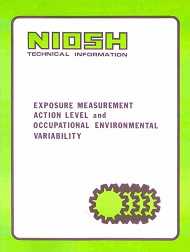Exposure Measurement and Action Level and Occupational Environmental Variability
December 1975
DHHS (NIOSH) Publication Number 76-131

The proposed Occupational Safety and Health Administration health standards define an exposure measurement action level as one half of the current permissible exposure limits. The action level is the point at which certain provisions of the proposed standards must be initiated, such as periodic employee exposure measurements and training of employees. The proposed employee exposure monitoring requirements are presented. Comparisions are made between employee exposure monitoring programs and industrial quality control programs. The application of the normal and lognormal frequency distributions to exposure measurements is discussed. Typical occupational variabilities for particulate, gas, and vapor samples are presented. Statistical theory is given for tolerance limits on time weighted average (TWA) daily exposures and associated employee risk curves. The action level was set with the view that the employer should minimize the probability that even a very low percentage of actual daily employee exposure (8 hour TWA) averages exceed the standard. Employee risk curves are presented which show the varying probability that at least 5% of an employee's unmeasured true daily exposure averages will exceed the standard given the fact that one day's measurement happened to fall below the standard by a specific amount. This calculated risk is almost solely a function of the day to day variability of the true 8-hour TWA exposures. Measurement error makes a very minor contribution to the calculated risk curves.
Exposure Measurement and Action Level and Occupational Environmental Variability [PDF - 1.45 MB]
- Page last reviewed: April 21, 2017
- Page last updated: April 21, 2017
- Content source:
- National Institute for Occupational Safety and Health Education and Information Division


 ShareCompartir
ShareCompartir